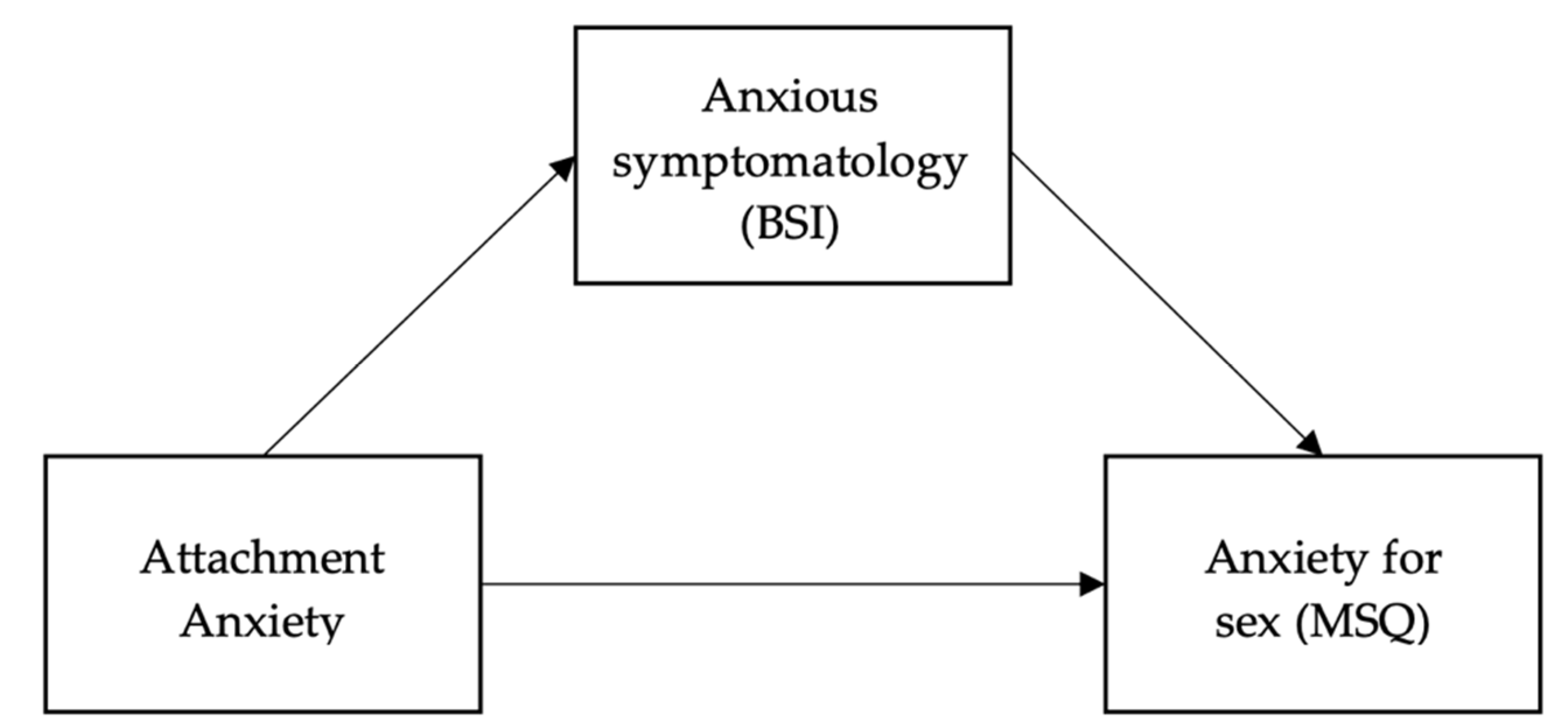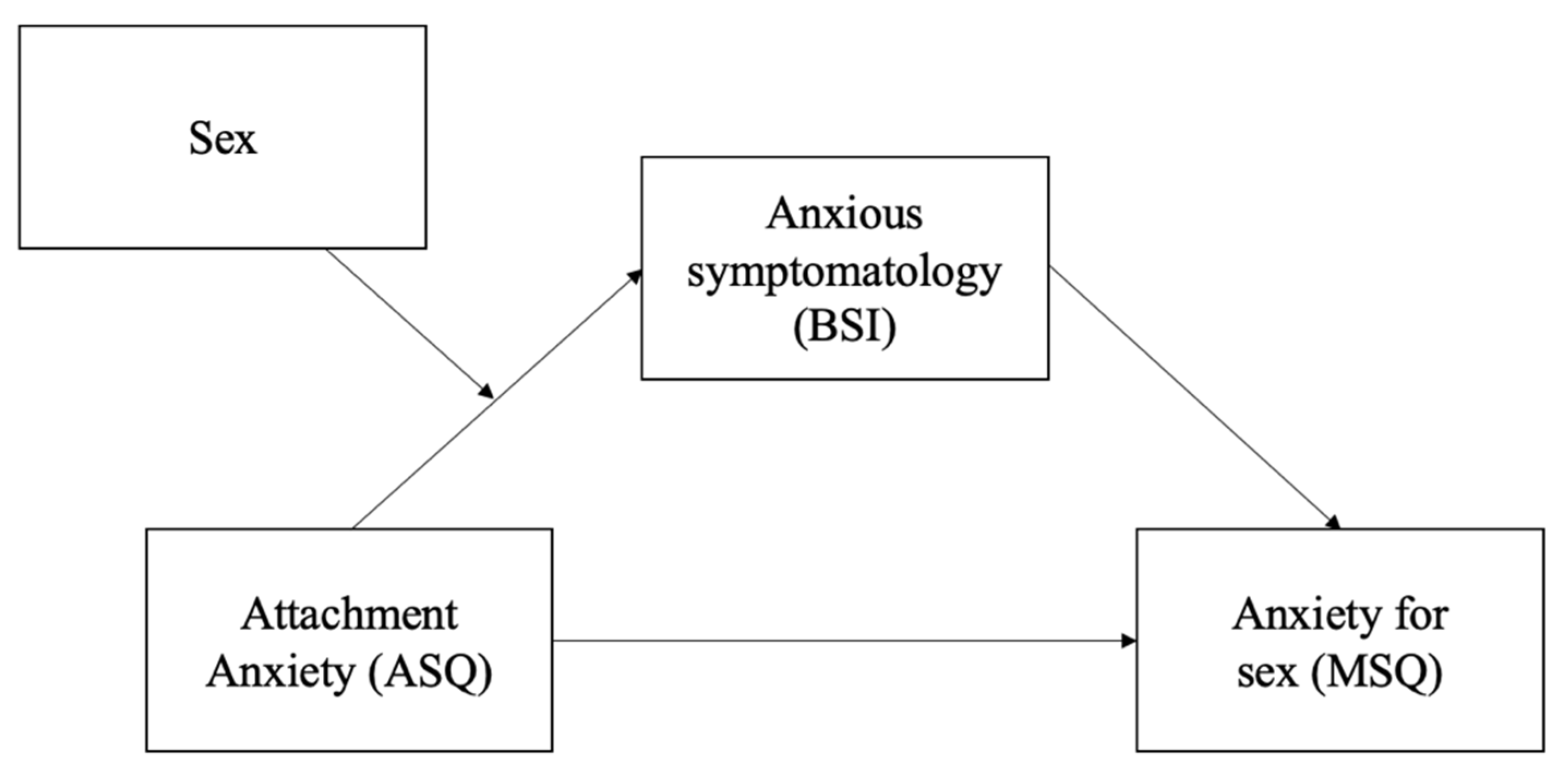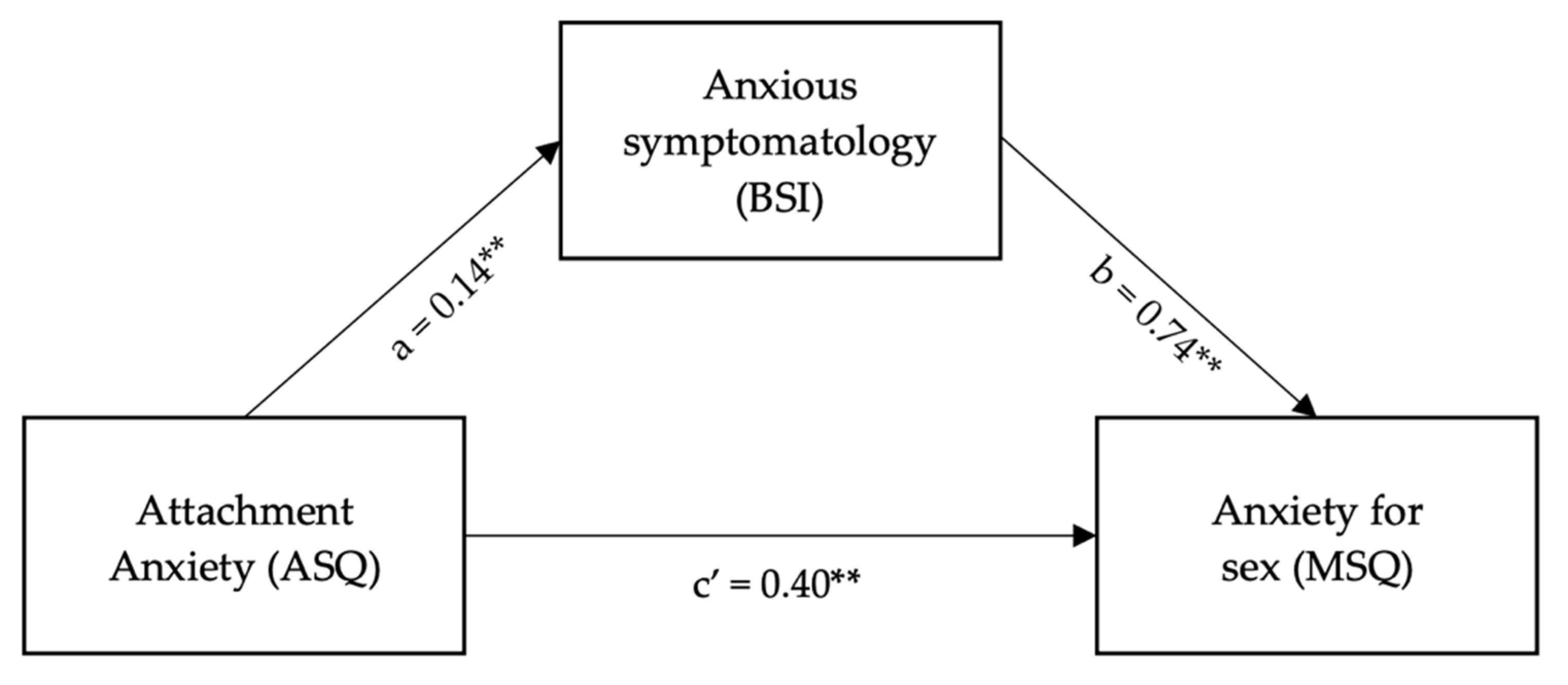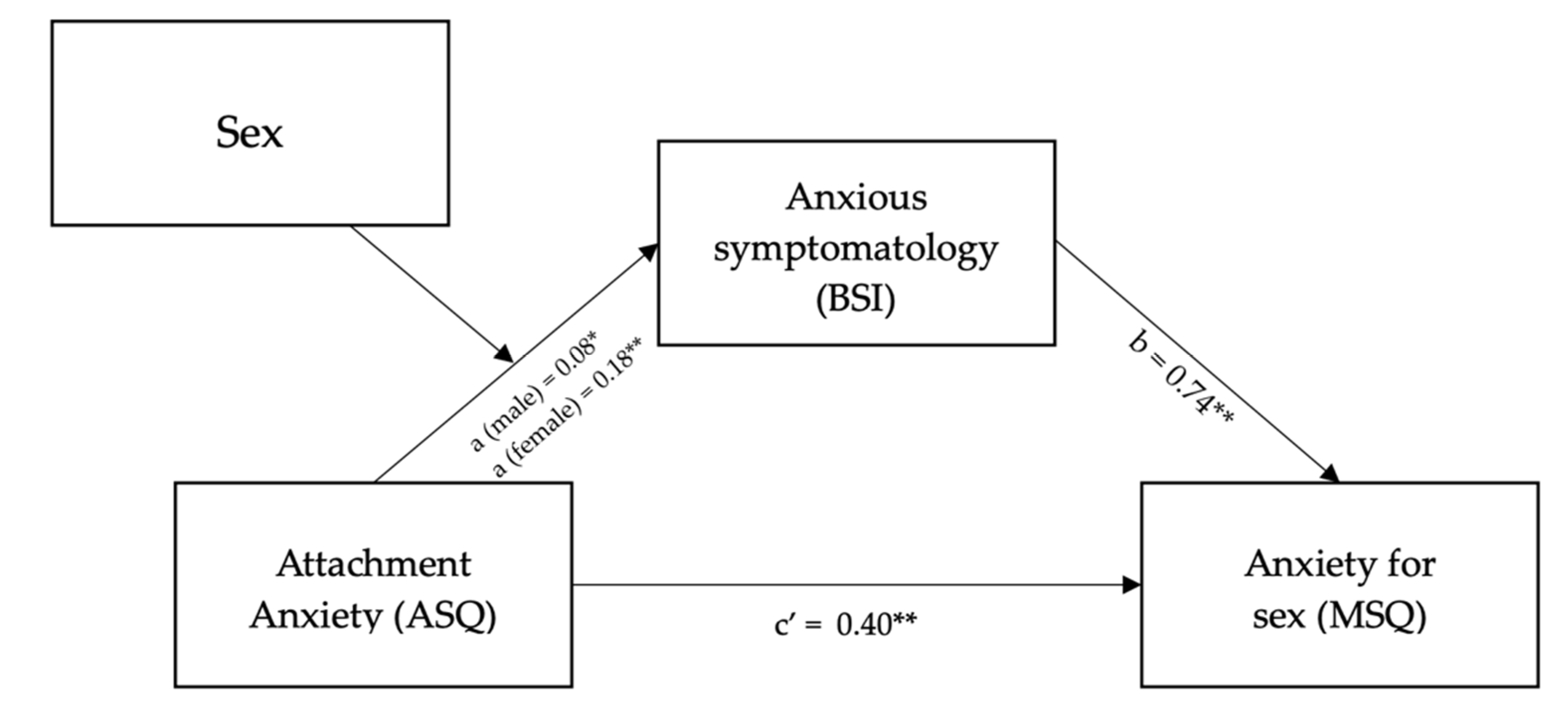Anxiety in Attachment and Sexual Relationships in Adolescence: A Moderated Mediation Model
Abstract
1. Introduction
1.1. Attachment and Anxiety Symptoms
1.2. Anxiety and Sexuality
1.3. Attachment and Sexuality
1.4. Attachment and Sexual Anxiety
1.5. Aims and Hypothesis
2. Materials and Methods
2.1. Participants
2.2. Measures
- Attachment Style Questionnaire: The ASQ is a 40-item self-report scale developed to assess several dimensions linked to attachment style, such as confidence, discomfort with closeness, need for approval, preoccupation for relationships, and relationships, as secondary. Moreover, this measure assesses avoidance and anxiety in attachment relationships. Participants are asked to rate aspects about them or others on a 6-point Likert scale (item example “I often wonder whether people like me”). The ASQ showed adequate reliability and construct validity in secondary student samples [48,49].
- Brief Symptoms Inventory: The BSI is a 53-item self-report scale developed to assess psychiatric disorder symptoms. Participants are asked to rate whether and how much they were distressed by different symptoms over the last week on a 5-point Likert scale (item example “during the past seven days, how much were you distressed by trouble concentrating”). BSI showed adequate reliability and construct validity [50].
- Multidimensional Sexuality Questionnaire: The MSQ is a 59-item self-report scale developed to assess several psychological dimensions linked to individual sexual life. Participants are asked to rate how much the item represents their sexual characteristics on a 5-point Likert scale (item example: “I feel anxious when I think about the sexual aspects of my life”). Out of the 12 dimensions obtainable by the MSQ, we focus on the anxiety scale, in which a higher score is presumed to represent a stronger and wider feeling of anxiety about sexual relationships. The MSQ showed adequate reliability and construct validity [51].
2.3. Procedure
2.4. Statistical Analyses
3. Results
3.1. Preliminary Analyses
3.2. Testing for Mediation
3.3. Testing for Moderated Mediation
4. Discussion
Limitations and Future Research
5. Conclusions
Author Contributions
Funding
Institutional Review Board Statement
Informed Consent Statement
Data Availability Statement
Conflicts of Interest
References
- Santona, A.; Tognasso, G. Attitudes Toward Homosexuality in Adolescence: An Italian Study. J. Homosex. 2018, 65, 361–378. [Google Scholar] [CrossRef] [PubMed]
- Tracy, J.L.; Shaver, P.R.; Albino, A.W.; Cooper, M.L. Attachment styles and adolescent sexuality. In Adolescent Romantic Relations and Sexual Behavior: Theory, Research, and Practical Implications; Lawrence Erlbaum Associates Publishers: Mahwah, NJ, USA, 2003; pp. 137–159. [Google Scholar]
- Chris Fraley, R.; Davis, K.E. Attachment formation and transfer in young adults’ close friendships and romantic relationships. Pers. Relatsh. 1997, 4, 131–144. [Google Scholar] [CrossRef]
- Cassidy, J.; Poehlmann, J.; Shaver, P.R. An attachment perspective on incarcerated parents and their children. Attach. Hum. Dev. 2010, 12, 285–288. [Google Scholar] [CrossRef] [PubMed]
- De Carli, P.; Riem Madelon, M.E.; Parolin, L. Approach-avoidance responses to infant facial expressions in nulliparous women: Associations with early experience and mood induction. Infant Behav. Dev. 2017, 49, 104–113. [Google Scholar] [CrossRef]
- Brennan, K.A.; Clark, C.L.; Shaver, P.R. Self-report measurement of adult attachment: An integrative overview. In Attachment Theory and Close Relationships; Simpson, J.A., Rholes, W.S., Eds.; The Guilford Press: New York, NY, USA, 1998; pp. 46–76. ISBN 1-57230-102-3. [Google Scholar]
- Cassidy, J.; Shaver, P.R.; Guilford, E.T. Handbook of Attachment Review; The Guilford Press: New York, NY, USA, 2010; pp. 57–58. [Google Scholar]
- McLaughlin, K.A.; Hatzenbuehler, M.L.; Hilt, L.M. Emotion Dysregulation as a Mechanism Linking Peer Victimization to Internalizing Symptoms in Adolescents. J. Consult. Clin. Psychol. 2009, 77, 894–904. [Google Scholar] [CrossRef]
- Gorrese, A. Peer Attachment and Youth Internalizing Problems: A Meta-Analysis. Child. Youth Care Forum 2016, 45, 177–204. [Google Scholar] [CrossRef]
- Nunes, S.A.N.; Faraco, A.M.X.; Vieira, M.L.; Rubin, K.H. Externalizing and internalizing problems: Contributions of attachment and parental practices. Psicol. Reflex. Crit. 2013, 26, 617–625. [Google Scholar] [CrossRef]
- Tambelli, R.; Laghi, F.; Odorisio, F.; Notari, V. Attachment relationships and Internalizing and Externalizing problems among Italian adolescents. Child. Youth Serv. Rev. 2012, 34, 1465–1471. [Google Scholar] [CrossRef]
- Mancinelli, E.; Li, J.; Lis, A.; Salcuni, S. Adolescents’ Attachment to Parents and Reactive—Proactive Aggression: The Mediating Role of Alexithymia. Int. J. Environ. Res. Public Health 2021, 18, 13363. [Google Scholar] [CrossRef]
- Loukas, A.; Prelow, H.M. Externalizing and internalizing problems in low-income Latino early adolescents: Risk, resource, and protective factors. J. Early Adolesc. 2004, 24, 250–273. [Google Scholar] [CrossRef]
- Van Minnen, A.; Kampman, M. The interaction between anxiety and sexual functioning: A controlled study of sexual functioning in women with anxiety disorders. Sex. Relatsh. Ther. 2000, 15, 47–57. [Google Scholar] [CrossRef]
- Figueira, I.; Possidente, E.; Marques, C.; Hayes, K. Sexual dysfunction: A neglected complication of panic disorder and social phobia. Arch. Sex. Behav. 2001, 30, 369–377. [Google Scholar] [CrossRef] [PubMed]
- Laurent, S.M.; Simons, A.D. Sexual dysfunction in depression and anxiety: Conceptualizing sexual dysfunction as part of an internalizing dimension. Clin. Psychol. Rev. 2009, 29, 573–585. [Google Scholar] [CrossRef] [PubMed]
- Dèttore, D.; Pucciarelli, M.; Santarnecchi, E. Anxiety and female sexual functioning: An empirical study. J. Sex Marital Ther. 2013, 39, 216–240. [Google Scholar] [CrossRef] [PubMed]
- O’Sullivan, L.F.; Brotto, L.A.; Byers, E.S.; Majerovich, J.A.; Wuest, J.A. Prevalence and characteristics of sexual functioning among sexually experienced middle to late adolescents. J. Sex. Med. 2014, 11, 630–641. [Google Scholar] [CrossRef]
- Schachner, D.A.; Shaver, P.R. Attachment dimensions and sexual motives. Pers. Relatsh. 2004, 11, 179–195. [Google Scholar] [CrossRef]
- Simpson, J.A. Influence of Attachment Styles on Romantic Relationships. J. Pers. Soc. Psychol. 1990, 59, 971–980. [Google Scholar] [CrossRef]
- Blanchard, M.; Miljkovitch, R. Attachement et Psychopathologie Durant L’enfance; Masso: Paris, France, 2002. [Google Scholar]
- Lang, M.; Matta, M.; Parolin, L.; Morrone, C.; Pezzuti, L. Cognitive Profile of Intellectually Gifted Adults: Analyzing the Wechsler Adult Intelligence Scale. Assessment 2019, 26, 929–943. [Google Scholar] [CrossRef]
- Hazan, C.; Zeifman, D.; Middleton, K. Adult romantic attachment, affection, and sex. In Proceedings of the 7th International Conference on Personal Relationships, Groningen, The Netherlands, 4–8 July 1994. [Google Scholar]
- Bogaert, A.F.; Sadava, S. Adult attachment and sexual behavior. Pers. Relatsh. 2002, 9, 191–204. [Google Scholar] [CrossRef]
- Birnbaum, G.E.; Reis, H.T.; Mikulincer, M.; Gillath, O.; Orpaz, A. When sex is more than just sex: Attachment orientations, sexual experience, and relationship quality. J. Pers. Soc. Psychol. 2006, 91, 929–943. [Google Scholar] [CrossRef]
- Gentzler, A.L.; Kerns, K.A. Associations between insecure attachment and sexual experiences. Pers. Relatsh. 2004, 11, 249–265. [Google Scholar] [CrossRef]
- Rinaldi, L.; Locati, F.; Parolin, L.; Bernardi, N.F.; Girelli, L. Walking on a mental time line: Temporal processing affects step movements along the sagittal space. Cortex 2016, 78, 170–173. [Google Scholar] [CrossRef] [PubMed]
- Pace, C.S.; Santona, A.; Zavattini, G.C.; Di Folco, S. Attachment States of Mind and Couple Relationships in Couples Seeking to Adopt. J. Child Fam. Stud. 2015, 24, 3318–3330. [Google Scholar] [CrossRef]
- Birnbaum, G.E. Attachment orientations, sexual functioning, and relationship satisfaction in a community sample of women. J. Soc. Pers. Relatsh. 2007, 24, 21–35. [Google Scholar] [CrossRef]
- Davis, D.; Shaver, P.R.; Widaman, K.F.; Vernon, M.L.; Follette, W.C.; Beitz, K. “I can’t get no satisfaction”: Insecure attachment, inhibited sexual communication, and sexual dissatisfaction. Pers. Relatsh. 2006, 13, 465–483. [Google Scholar] [CrossRef]
- Feeney, J.A. Implications of attachment style for patterns of health and illness. Child Care Health Dev. 2000, 26, 277–288. [Google Scholar] [CrossRef]
- Brassard, A.; Shaver, P.R.; Lussier, Y. Attachment, sexual experience, and sexual pressure in romantic relationships: A dyadic approach. Pers. Relatsh. 2007, 14, 475–493. [Google Scholar] [CrossRef]
- Santona, A.; Vecchi, A.; Gorla, L.; Tognasso, G. Parenthood Desire in Italian Homosexual Couples. J. Fam. Issues 2021. [Google Scholar] [CrossRef]
- Birnie, C.; McClure, M.J.; Lydon, J.E.; Holmberg, D. Attachment avoidance and commitment aversion: A script for relationship failure. Pers. Relatsh. 2009, 16, 79–97. [Google Scholar] [CrossRef]
- Brennan, K.A.; Shaver, P.R. Dimensions of Adult Attachment, Affect Regulation, and Romantic Relationship Functioning. Personal. Soc. Psychol. Bull. 1995, 21, 267–283. [Google Scholar] [CrossRef]
- Dang, S.S.; Northey, L.; Dunkley, C.R.; Rigby, R.A.; Gorzalka, B.B. Sexual anxiety and sexual beliefs as mediators of the association between attachment orientation with sexual functioning and distress in university men and women. Can. J. Hum. Sex. 2018, 27, 21–32. [Google Scholar] [CrossRef]
- Stefanou, C.; Mccabe, M.P. Adult Attachment and Sexual Functioning: A Review of Past Research. J. Sex. Med. 2012, 9, 2499–2507. [Google Scholar] [CrossRef] [PubMed]
- Brassard, A.; Dupuy, E.; Bergeron, S.; Shaver, P.R. Attachment insecurities and women’s sexual function and satisfaction: The mediating roles of sexual self-esteem, sexual anxiety, and sexual assertiveness. J. Sex Res. 2015, 52, 110–119. [Google Scholar] [CrossRef] [PubMed]
- Burri, A.; Schweitzer, R.; O’Brien, J. Correlates of Female Sexual Functioning: Adult Attachment and Differentiation of Self. J. Sex. Med. 2014, 11, 2188–2195. [Google Scholar] [CrossRef]
- Dunkley, C.R.; Dang, S.S.; Chang, S.C.H.; Gorzalka, B.B. Sexual Functioning in Young Women and Men: Role of Attachment Orientation. J. Sex Marital Ther. 2016, 42, 413–430. [Google Scholar] [CrossRef]
- van den Brink, F.; Smeets, M.A.M.; Hessen, D.J.; Woertman, L. Positive Body Image and Sexual Functioning in Dutch Female University Students: The Role of Adult Romantic Attachment. Arch. Sex. Behav. 2016, 45, 1217–1226. [Google Scholar] [CrossRef][Green Version]
- Lis, A.; Parolin, L.; Calvo, V.; Zennaro, A.; Meyer, G. The impact of administration and inquiry on Rorschach comprehensive system protocols in a national reference sample. J. Pers. Assess. 2007, 89, S193–S200. [Google Scholar] [CrossRef]
- Dang, S.S.; Gorzalka, B.B. Insecure Attachment Style and Dysfunctional Sexual Beliefs Predict Sexual Coercion Proclivity in University Men. Sex. Med. 2015, 3, 99–108. [Google Scholar] [CrossRef][Green Version]
- Butzer, B.; Campbell, L. Adult attachment, sexual satisfaction, and relationship satisfaction: A study of married couples. Pers. Relatsh. 2008, 15, 141–154. [Google Scholar] [CrossRef]
- Goldsmith, K.M.; Dunkley, C.R.; Dang, S.S.; Gorzalka, B.B. Sexuality and romantic relationships: Investigating the relation between attachment style and sexual satisfaction. Sex. Relatsh. Ther. 2016, 31, 190–206. [Google Scholar] [CrossRef]
- Janda, L.; O’Grady, K.E. Development of a Sex Anxiety Inventory. J. Consult. Clin. Psychol. 1980, 48, 169–175. [Google Scholar] [CrossRef] [PubMed]
- Stefanou, C. The Associations Among Adult Attachment, Relationship Functioning, and Sexual Functioning. Ph.D. Thesis, Deakin University, Geelong, Australia, 2013. [Google Scholar]
- Feeney, J.A.; Noller, P.; Hanrahan, M. Assessing adult attachment. In Attachment in Adults: Clinical and Developmental Perspectives; The Guilford Press: New York, NY, USA, 1994; pp. 128–152. ISBN 0898625475. [Google Scholar]
- Fossati, A.; Feeney, J.A.; Donati, D.; Donini, M.; Novella, L.; Bagnato, M.; Acquarini, E.; Maffei, C. On the dimensionality of the attachment style questionnaire in Italian clinical and nonclinical participants. J. Soc. Pers. Relatsh. 2003, 20, 55–79. [Google Scholar] [CrossRef]
- Derogatis, L.R. BSI Brief Symptom Inventory. In Administration, Scoring, and Procedures Manual; National Computer Systems: Minneapolis, MN, USA, 1993; p. 1. [Google Scholar]
- Snell, W.E.; Fisher, T.D.; Walters, A.S. The multidimensional sexuality questionnaire: An objective self-report measure of psychological tendencies associated with human sexuality. Ann. Sex Res. 1993, 6, 27–55. [Google Scholar] [CrossRef]
- Hayes, A.F. Integrating Mediation and Moderation Analysis: Fundamentals using PROCESS; The Guilford Press: New York, NY, USA, 2013. [Google Scholar]
- Hayes, A.F. An Index and Test of Linear Moderated Mediation. Multivar. Behav. Res. 2015, 50, 1–22. [Google Scholar] [CrossRef]
- Santona, A.; De Cesare, P.; Tognasso, G.; De Franceschi, M.; Sciandra, A. The mediating role of romantic attachment in the relationship between attachment to parents and aggression. Front. Psychol. 2019, 10, 1824. [Google Scholar] [CrossRef]
- Potard, C.; Courtois, R.; Réveillère, C.; Bréchon, G.; Courtois, A. The relationship between parental attachment and sexuality in early adolescence. Int. J. Adolesc. Youth 2017, 22, 47–56. [Google Scholar] [CrossRef]
- Pace, C.S.; Muzi, S.; Parolin, L.; Milesi, A.; Tognasso, G.; Santona, A. Binge eating attitudes in community adolescent sample and relationships with interview-assessed attachment representations in girls: A multi-center study from North Italy. Eat. Weight Disord.-Stud. Anorex. Bulim. Obes. 2022, 27, 495–504. [Google Scholar] [CrossRef]
- George, C.; Kaplan, N.; Main, M. An Adult Attachment Interview: Interview Protocol, 3rd ed.; University of California: Berkely, CA, USA, 1984. [Google Scholar]




| N | % | |
|---|---|---|
| Gender | ||
| Male | 189 | 38.3% |
| Female | 304 | 61.7% |
| PMStatus | ||
| Married | 439 | 89% |
| Divorced | 53 | 10.8% |
| Missing | 1 | 0.2% |
| RomRel | ||
| Yes | 185 | 37.5% |
| No | 307 | 62.3% |
| Missing | 1 | 0.2% |
| SigRel | ||
| Yes | 256 | 51.9% |
| No | 219 | 44.4% |
| Missing | 1 | 0.2% |
| SigFr | ||
| Yes | 412 | 83.6% |
| No | 66 | 13.4% |
| Missing | 15 | 3% |
| M | SD | |
|---|---|---|
| ASQ-Anx | −0.72 | 1.6 |
| BSI-Anx | 1.95 | 0.78 |
| MSQ-Anx | 5.34 | 4.06 |
| ASQ-Anx | BSI-Anx | MSQ-Anx | |
|---|---|---|---|
| ASQ-Anx | - | ||
| BSI-Anx | 0.29 ** | - | |
| MSQ-Anx | 0.20 ** | 0.19 ** | - |
Publisher’s Note: MDPI stays neutral with regard to jurisdictional claims in published maps and institutional affiliations. |
© 2022 by the authors. Licensee MDPI, Basel, Switzerland. This article is an open access article distributed under the terms and conditions of the Creative Commons Attribution (CC BY) license (https://creativecommons.org/licenses/by/4.0/).
Share and Cite
Santona, A.; Milesi, A.; Tognasso, G.; Gorla, L.; Parolin, L. Anxiety in Attachment and Sexual Relationships in Adolescence: A Moderated Mediation Model. Int. J. Environ. Res. Public Health 2022, 19, 4181. https://doi.org/10.3390/ijerph19074181
Santona A, Milesi A, Tognasso G, Gorla L, Parolin L. Anxiety in Attachment and Sexual Relationships in Adolescence: A Moderated Mediation Model. International Journal of Environmental Research and Public Health. 2022; 19(7):4181. https://doi.org/10.3390/ijerph19074181
Chicago/Turabian StyleSantona, Alessandra, Alberto Milesi, Giacomo Tognasso, Laura Gorla, and Laura Parolin. 2022. "Anxiety in Attachment and Sexual Relationships in Adolescence: A Moderated Mediation Model" International Journal of Environmental Research and Public Health 19, no. 7: 4181. https://doi.org/10.3390/ijerph19074181
APA StyleSantona, A., Milesi, A., Tognasso, G., Gorla, L., & Parolin, L. (2022). Anxiety in Attachment and Sexual Relationships in Adolescence: A Moderated Mediation Model. International Journal of Environmental Research and Public Health, 19(7), 4181. https://doi.org/10.3390/ijerph19074181






